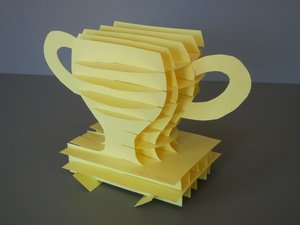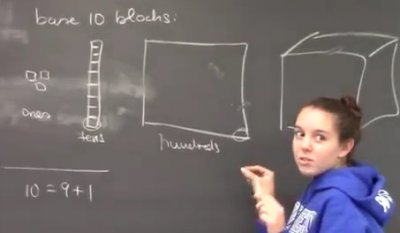The First Class of the Semester: Setting the Stage
Written by: Dr. Volker Ecke with Dr. Christine von Renesse
 I'm getting ready for the first day of class of the semester, excited to meet a new group of students in my mathematics for liberal arts class. As I'm making decision about my goals, and planning my teacher actions in the classroom, I invite you to come along.
I'm getting ready for the first day of class of the semester, excited to meet a new group of students in my mathematics for liberal arts class. As I'm making decision about my goals, and planning my teacher actions in the classroom, I invite you to come along.
As I prepare, these are some of the questions about my larger goals that are going through my mind:
- How do I get the students "on board" with engaging in Inquiry-Based Learning activities?
- How do I create a community of learners?
- How do I communicate my expectations, and my reasons for teaching in this "new" way?
- How do I show the students that I trust that they can do mathematics and learn mathematics without an expert first telling them exactly how do solve the problem?
Together with my partners in the DAoM project, we recently reflected on how we use the first class to set the stage for successful student learning throughout the semester. Here are some of our ideas and considerations.
Audience & Goals
What are the aspects of the class that are most important to me throughout the semester: Do I want to place an emphasis on proof? Will the students create mathematical art? Will writing be an integral aspect of the course? Do I plan to use movement and dance? I want the student to experience these aspects in the very first class.
I have certain routines that are important in how I run the class. Some of these can be crucial to start in the first class. For example, if I plan to use students' nametags to reassign students to new groups for every class meeting, it's important to announce and start that right away. Similarly, if I plan to use talk moves to facilitate whole class discussions among the students, it is helpful to start off with those right away. What are some class norms and routines that are important for you to establish from the start?
Many students in our mathematics for liberal arts class have come away from their prior mathematical experiences with low confidence or anxiety about their ability to be successful in mathematics. It can be important for them to realize that they are not the only students in this class with that kind of experience; that I am aware of their experiences; that we will walk a different path; and that I have full confidence that they will be successful in this class.
You Can Do It: Cool Student Work from Previous Classes
I trust that students in this class will do amazing mathematical work. One way to communicate that is to show them some of the amazing mathematical work that students have created in prior semesters. Here are some items that we have used: various student-designed sliceforms ("Geometry"), String Art ("Calculus"), Möbius bands ("Art & Sculpture"), Rubik's Cubes ("Games & Puzzles"), student-designed 3D models of buildings in Westfield in Google Earth ("Geometry"), etc.
This helps in creating an open mind, often connects with students' non-mathematical interests, and raises some curiosity about what this class will actually be like. The following video shows Julian Fleron showing his students some amazing mathematical student work.
You Can Do It II: Jump right into activities
On each and every day, I want my students to be actively engaged in making sense of mathematical investigations, usually in a small group setting, because I believe that this is integral to their learning of mathematics. I fully trust that they can make sense of a mathematical problem on their own, from start to finish, and that they will construct important mathematical ideas in the process. One way to communicate this expectation and to show this trust is to jump right into activities on the first day. For examples and handouts, see our Blog on Good First Day Activities.
Once the problem is clear, I need to give the students some time and space to get started in their group. Sometimes I pretend to be busy with some technical details at my desk to give them this space. There is often some surprise and uncertainty about what they are expected to do because I haven't first explained to them how to get started. Students' prior experience in mathematics has been exactly that; a teacher would typically first explain how to solve a particular type of problem on the board. Students would then be asked to mimic and build on this particular method. This class will be very different and they need to become aware that their expectation that I will come around and bail them out is not going to happen. I want to communicate that I trust them to get started with the problem on their own.
I also find that writing about their reasoning is a strength these liberal arts majors bring to the task. I may choose an assignment that explicitly includes some writing. At this point, I can point out explicitly that talking about their thinking in their groups is an important tool they should use. In the following video, Julian Fleron tells students that there is "No Whispering!" in his his class, expecting them to discuss loud and clear.
Check out our Blog on Good Activities to find class handouts and classroom videos.
What we value: Expectations and Grading
What we value in class and expect from students and how that is reflected in our grading also helps students settle into the class. The following videos show Christine von Renesse sharing her view of what it means to do mathematics as well as her expectations for participation and writing in her class.
Class participation
Writing in mathematics
Building a Community of Learners: Gallery Walk
Many students in the liberal arts have had mixed experiences with mathematics in the past and do not feel very confident in their mathematical abilities. For students to take risks with suggesting mathematical ideas in their group or to the whole class, they need to feel safe. It is important to create a community of learners where even rough (or ultimately incorrect) ideas are acknowledged as valuable contributions.
Sometimes, a brief remark can communicate our conviction that "Students in this classroom can accomplish as much as any student anywhere." Here is Julian Fleron taking the opportunity to make this point after watching a short segment from the movie "Stand And Deliver".
This semester, Phil and I used a "gallery walk" to share prior experiences with mathematics, to learn about our students, and to start building community. We wrote the following questions on the nine blackboards that wrap around our classroom and asked each table to rotate around, filling in their responses to each question.
A gallery walk is a teaching technique where we all get to participate in sharing our views on a number of questions or prompts. Our purpose here is for you to share so we can all better understand why each of us is in this course.
- What are some words you would use to describe mathematics?
- Why are you taking this class? What do you hope to get out of this course?
- What are your favorite mathematical topics, if any? (Please be specific.)
- What do you think mathematicians do?
- What were your high school experiences in geometry? What are some of the geometric objects you studied?
- Who are some famous mathematicians?
- Can you name some contemporary mathematicians? I.e. mathematicians from the 20th or 21st century?
- What subjects do you like learning about? (This question is not restricted to just mathematics.)
- What is worth knowing? (This question is not restricted to just mathematics.)
Once the groups are done, we facilitate a whole class discussion about some of the responses, highlighting common experiences, asking for clarification, validating students taking risks in sharing, and crystallizing our hopes for the learning experience in this class. It helps launch a warm community of learners where everybody's voices are heard.
Reflection
Having just done the gallery walk, I noticed that a lot of air time during the class was given to negative experiences, and not enough to showing positive alternatives. For the next time, I'm planning to bring with me a few more of the "Cool Things" students created in prior years, and to ensure we get into some intriguing mathematical activities.
How About You?
What are some of your goals for a first class? What approaches have worked well for you, and could be helpful for other faculty? What are questions of challenges you encounter? Please share them by sending us a note!

